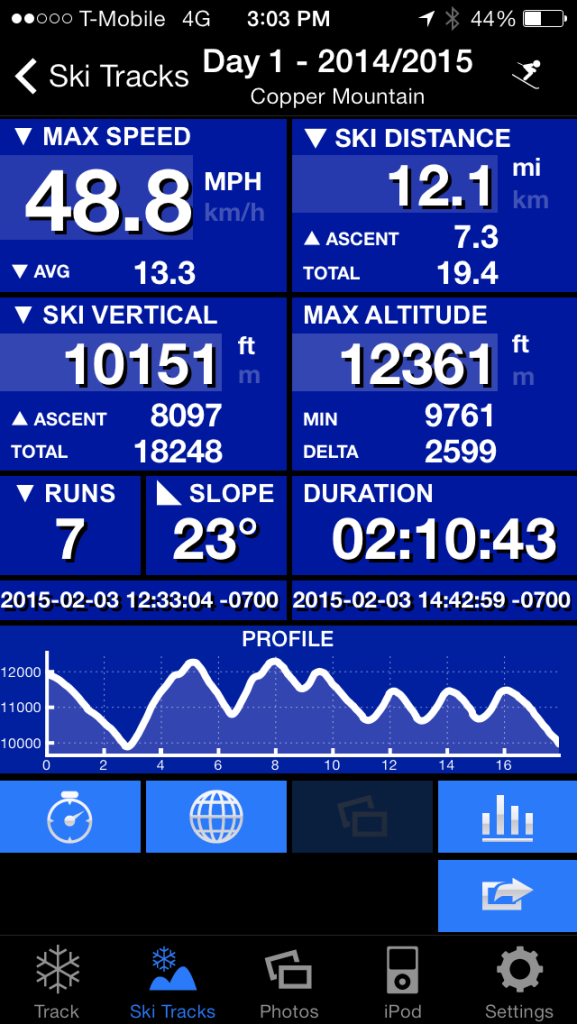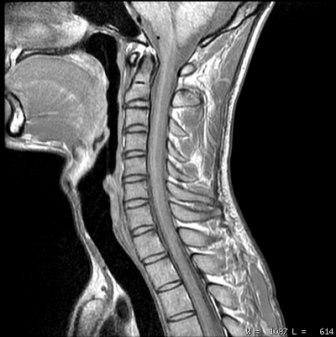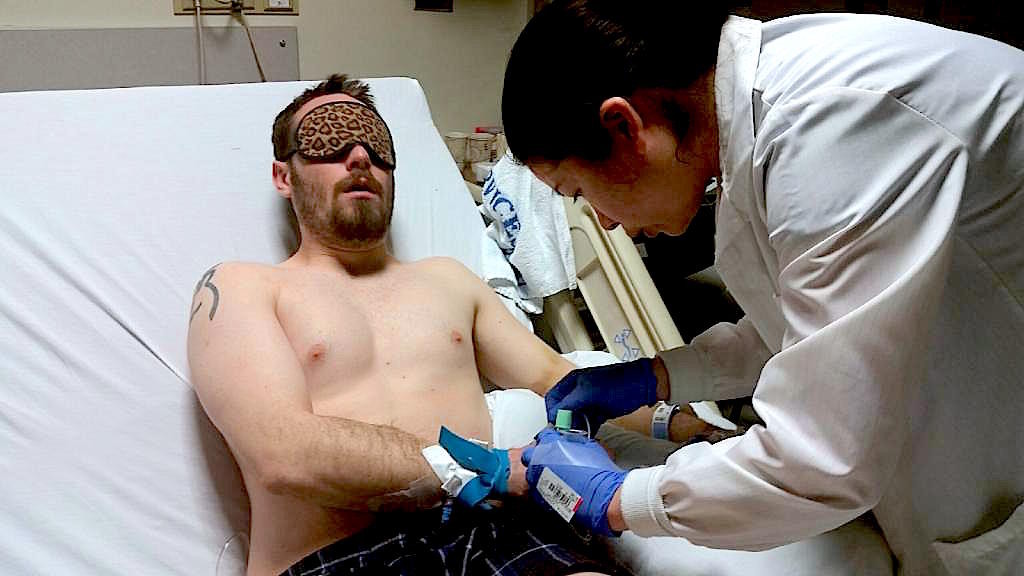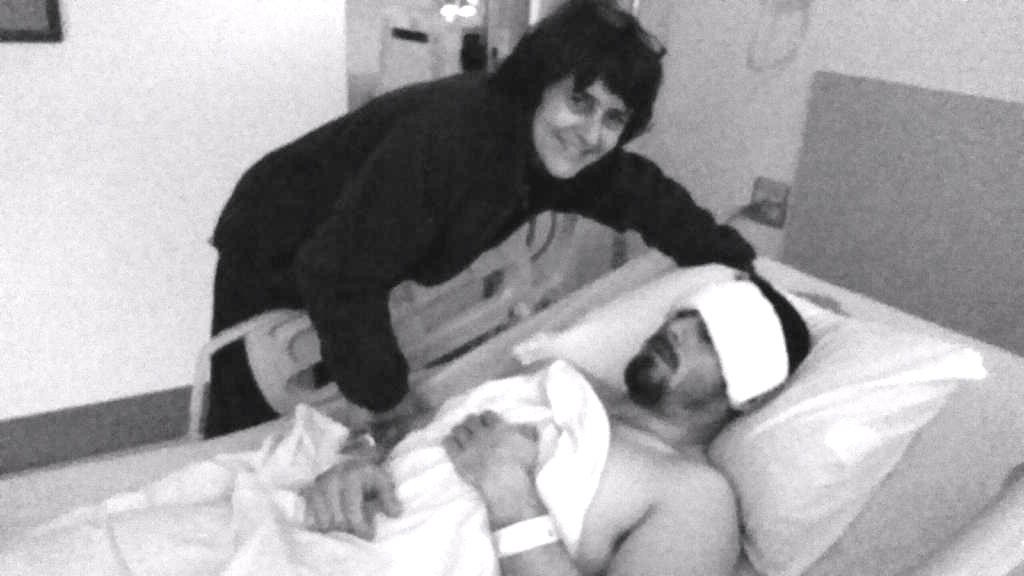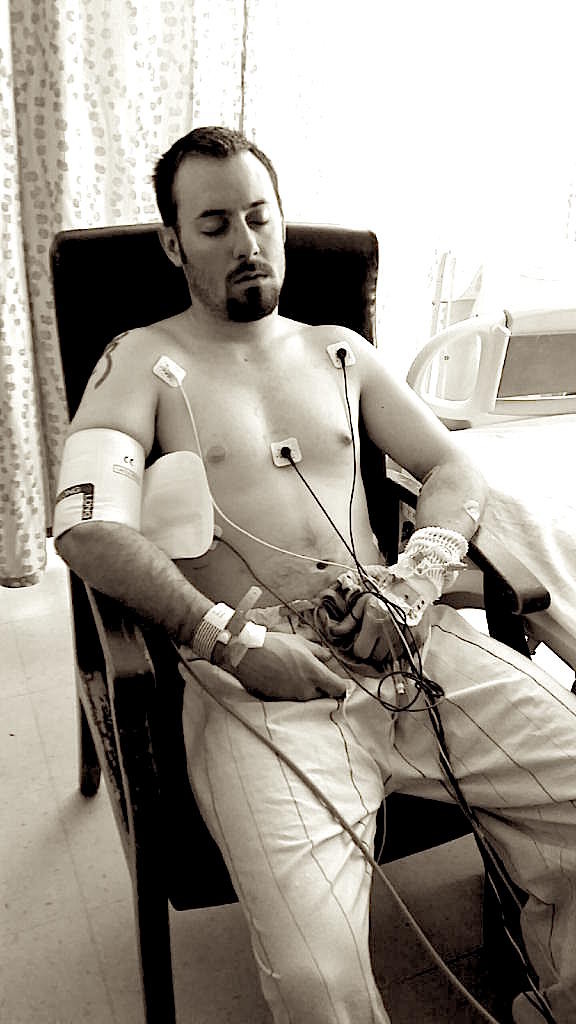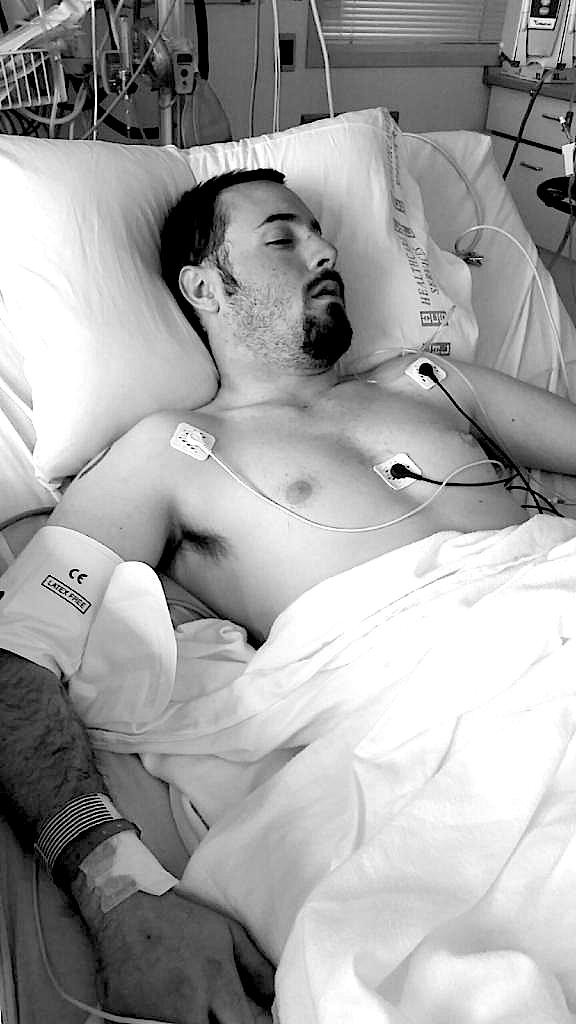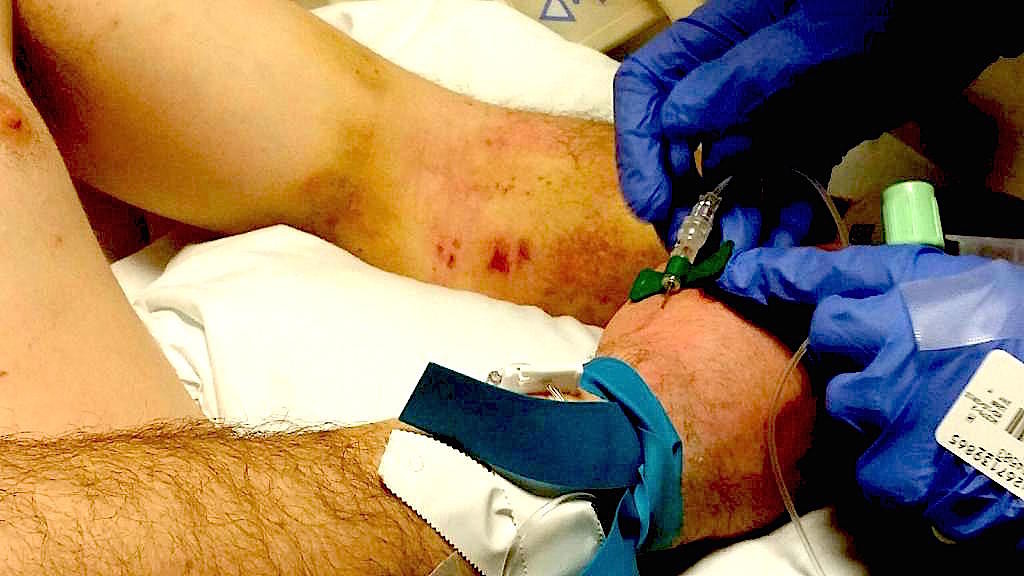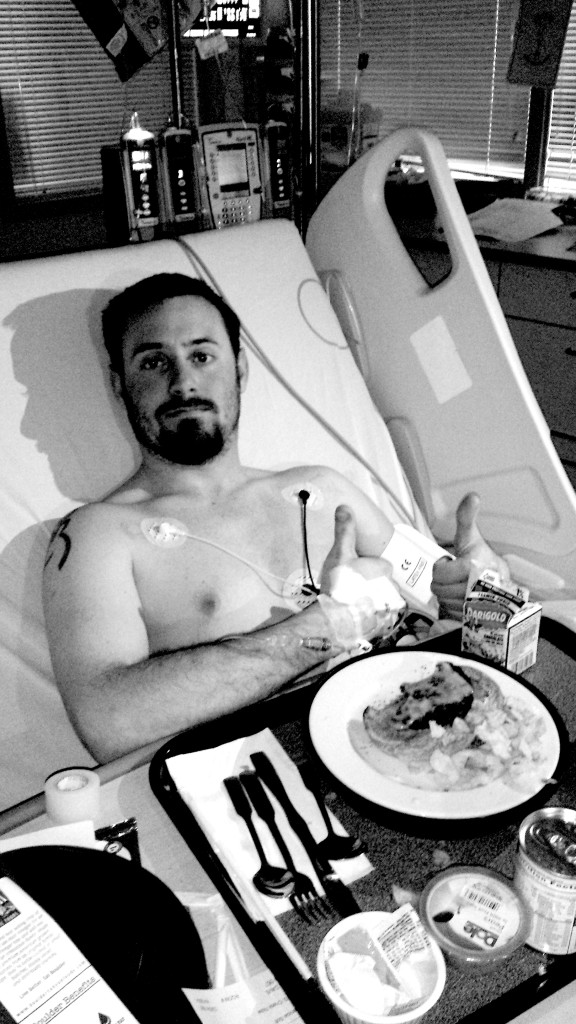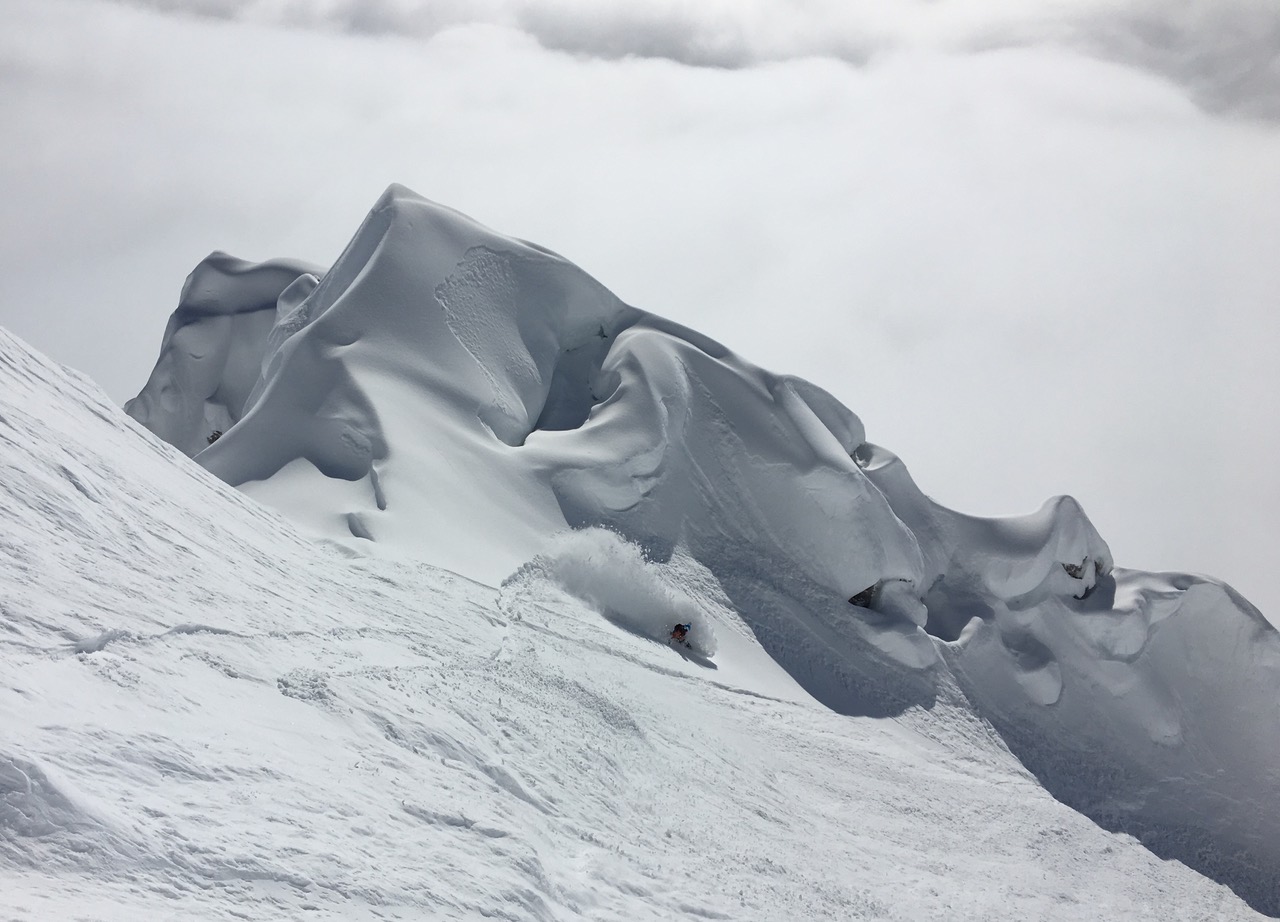Helmet use and its correlation to traumatic brain injury, spinal cord injury, and risk-taking behavior in snowboarding and skiing: A VERY brief review of literature.
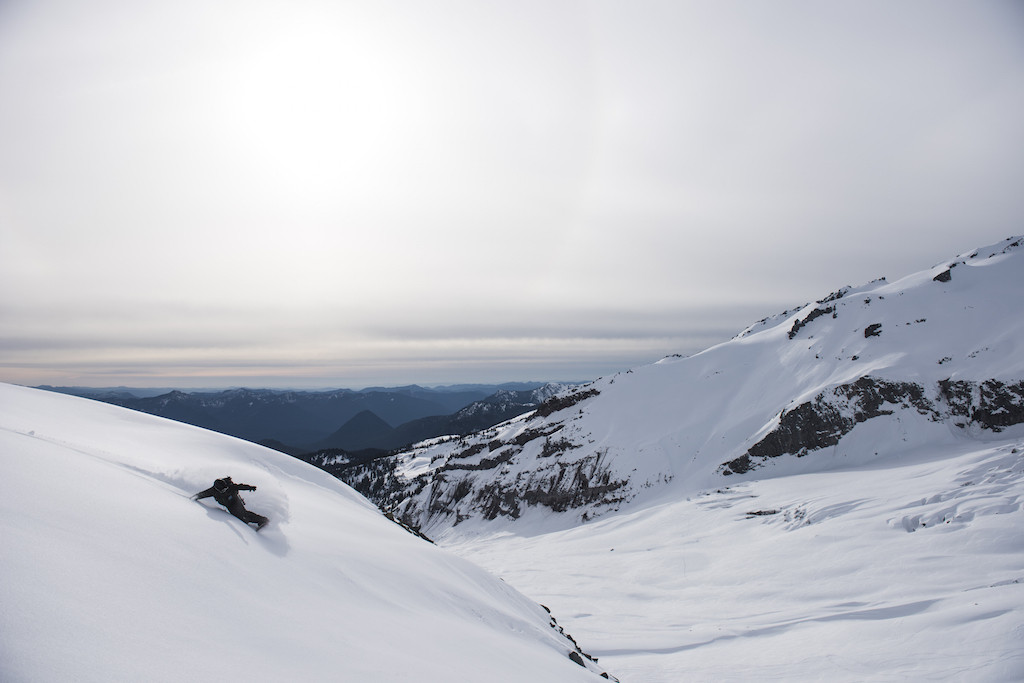
David “Splitstoke” Benton. Mount Rainier, February 2015, just a few weeks before he nearly lost his life to a Traumatic Brain Injury. Photo: Paul Stanley
David is a fast, powerful snowboarder, and it was with a halting CRACK that his skull impacted the tree at Stevens Pass, Washington.
He had been snowboarding all morning with his friend Jay. Although it had been the worst winter in recorded Northwest history, they were enjoying soft spring snow conditions. David has a history of always wearing a helmet while snowboarding. On this day, however, he did not put it on. It was sitting in the back seat of his car down in the parking lot. Nobody knows exactly how it happened (David can’t remember) but he lost control while straight-lining out the bottom of one of Stevens Pass’ bowl runs and hit some stickier, slower snow. This caused him to lose control and to be launched into the tree. Upon impact, the rear of his skull fractured into several pieces and pressed hard into the occipital lobe of his brain. He was knocked instantly unconscious. By pure luck, a couple of skiers saw him lying in the snow and called ski patrol. Through the efficient and succinct work of the Stevens pass ski patrol and paramedics, within 45 minutes of crashing David was in a helicopter on his way to Harborview’s Intensive Neurologic Injury Center.
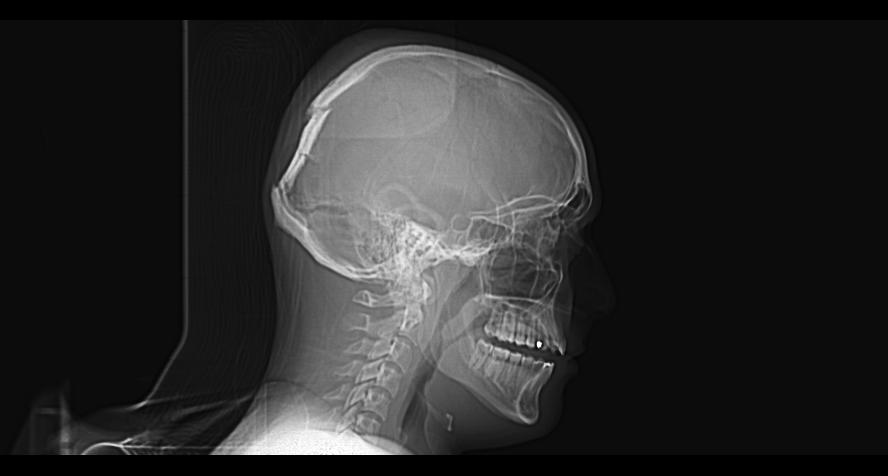
Dave’s first X-ray at Harborview. Note the compound fracture pressing into his brain in the rear of his skull
MISSION:
What we want to discuss in this blog post is [some] of the key, most well-respected research articles on Traumatic Brain Injury (TBI) amongst snowboarders and skiers, and what role helmets may play to help increase your margin of safety. Furthermore, because many people out there might question whether or not helmets might increase the risk of neck injury, we dove into some of the clinical data on that topic as well. Lastly, we have heard many times from our snowboarding peers that “Helmets make me more reckless, and more likely to crash and get hurt”. To address this we looked at a few studies that measured correlations between helmet use, risk-taking behavior, and head injury rates among highly experienced snowboarders and skiers.
REVIEW OF LITERATURE: TRAUMATIC BRAIN INJURY
According to the Centers for Disease Control and Prevention, the single greatest cause of death for persons aged 1 to 44 years is what they call “All Cause Traumatic Injury” (1). Within the sub-category of traumatic injury, TBI accounts for as much as 40% of all deaths nation-wide (2). Within snowboarding and skiing, head injury is the greatest cause of severe injury resulting in hospitalization, and out of all TBI hospitalizations, there is approximately an 8% rate of mortality (4, 9, 11). In 2002 Levy and colleagues reported that while most cases of hospitalized head injury are “mild”, TBI is still the number one cause of traumatic death in the ski / snowboard population.
Here is a diagram of the “Glasgow Coma Scale” (GCS) that is used to classify head injury:
| Glasgow Coma Score: | Neurological Findings | Grade of Severity | N=669(Mathematical constant) | Approximate percentage of all TBI injuries |
| 15 | Inconspicuous neurology | Conscious | 467 | 71.1 |
| 13-14 | Mild neurological disorder | Cerebral commotion, e.g. TBI grade 1 | 95 | 14.2 |
| 9-12 | Moderate neurological disorder | Clouded awareness, cerebral contusion, e.g. TBI grade 1-2 | 29 | 4.4 |
| 6-8(David’s State upon admission to ICU) | Severe neurological disorder | Clouded awareness to unconsciousness, e.g. TBI grade 2-3 | 27 | 4.0 |
| 3-5 | Most severe neurological disorder | Unconscious, coma, e.g. TBI grade 3 | 42 | 6.3 |
Levy and colleagues found in their research that simple contusions (GCS score of 13-15) made up 81% of all TBI’s, but that 14% of all subjects were classified as severe brain injuries (GCS scores of 3-8) (9). Primary mechanisms of injury were as follows:
- Collision with a tree or other stationary objects: 47%
- Simple falls impacting the ground: 37%
- Collision with another skier / rider: 13%
- Major (high speed) falls impacting the ground: 3%
In terms of which types of falls resulted in the most severe cases of TBI, impacting trees and “major falls” accounted for the highest percentage of severe and fatal injuries. Of all tree impacts, the average Glasgow Coma Scale values fell into the 3 to 8 categories (9). Furthermore, of all tree impact related TBI’s, 7.2% of all subjects died.
What this means (based on the statistics from this study) is that if you impact a tree at high speed, you are 7 out of 100 times likely to die. And if you don’t die, you are 47 out of 100 times (~50% of the time) likely to suffer permanent, lasting brain injury (4). It is important to note however, that this study did not distinguish whether or not a subject was wearing a helmet at the time of impact. That being said, the authors discussed in their conclusions that helmet use could have a significant, major impact on reducing the statistics for severe and fatal TBI (9).
A study published in the Journal of the American Medical Association examined more specifically the statistical impact of wearing a helmet on the incidence of mild to severe head injury, and the risk for mortality (15). Sulheim and others noted that head injuries still happen even with helmet use, and tested the long-standing cultural assumption that helmets reduce the risk for head injury.
In order to place real data against this assumption, the authors applied a case-controlled study to 8 major Norwegian alpine ski resorts for a full season in 2002. Subjects for analysis included over 3,277 injured skiers and snowboarders reported by ski patrol, and also 2992 non-injured control subjects that were randomly selected for ski and snowboard habits (ie. report of helmet use, number of days on slope each season etc.). The number of control subjects interviewed was representative of each ski resort’s anticipated number of injuries, based on previous season’s records. The primary outcome measures in this study were:
- Injury type
- Helmet use
- Other risk factors: (age, skill level, sex, fitness, nationality, equipment used, ski school attendance, rented or owned equipment)
The authors compared Skiers and snowboarders with head injuries to subjects without head injuries, as well as to subjects with other (non TBI) injuries. A multivariate logistic regression analysis was used to assess the correlation between individual risk factors and injury type (helmet use / no helmet use, skill level, equipment quality etc.). Of all reported injuries, TBI accounted for 17.6% of all hospitalizations, or 578 total reported head injuries. The subjects at highest risk for TBI were beginners, individuals of male gender, and they found that snowboarders were at a higher risk than skier counterparts. Results indicated a statistically significant reduction in the risk of moderate to severe TBI when a helmet was worn. In fact, when helmet use was compared against all injuries, as well as to all other risk variables, the data indicated that wearing a helmet reduced the risk of moderate to severe TBI by as much as 60% (15). Although there are limitations to any scientific study, this investigation incorporated a very large sample size, and had a very high degree of statistical power.
Relevance of Sulheim investigation:
The most important thing to reiterate about this study, was that no matter what skill level, age, sex, nationality, ski vs. snowboard, or any other reported risk factor, wearing a helmet had a major statistically significant impact on reducing the risk of head injury amongst all groups. Even if you are a professional or expert snowboarder or skier, and feel that you are not at risk for severe TBI while on the slopes, these data indicate that:
1) Severe TBI can and does occur to any group of ski resort users, including “experts”, and
2) Wearing a helmet reduces your risk by as much as 60%, even amongst those classified as “high risk taker” snowboarders and skiers (7).
Surprisingly, the statistics on helmet use in snow sports crosses into the literature on helmet use in many other high velocity activities. We have known for years that wearing a helmet while riding a motorcycle, ATV, or while riding a bicycle has a profound impact on saving lives. What we didn’t realize before was that the statistics across these areas is very similar to the 60-70% TBI protective qualities for helmets in snow sports. For example, those who ride recreational all-terrain vehicles (ATV’s) have a 64% greater chance of avoiding severe TBI if they wear an industry standard helmet (5). In 2000, Thompson and others ran a large-scale Meta-Analysis*** on studies that examined helmet use in bicyclists in the United States. These authors pointed out that each year, roughly 500,000 people are hospitalized from bike crashes, and that on average, 900 die from head injuries. Based on the data from case-controlled studies, they found that helmets reduce the risk for severe TBI in cyclists by 63-88%. More specifically, in bicycle crashes involving motor vehicles (being hit by a car while on a bike) helmets offered a 69% greater chance of survival, and in all other types of crashes, a 68% greater chance of survival (18). Although the mechanism of injury may be slightly different for bicycle crashes as compared to snow sports, its important to remember that while sliding on your snowboard or skis, people often reach velocities that replicate highway and freeway speeds.
Here is data from the mobile ski application “Ski Tracks”. Ski Tracks was developed by biomechanics researchers, and utilizes the WAAS-enabled Global Positioning technology that is present in most mobile smart phones. It tracks over-ground velocities, vertical gain and loss, as well as changes in acceleration. The author of this review recorded these data on a “mellow afternoon of riding” at Copper Mountain Resort in Colorado, USA:
This was considered a “powder day”, when most of the terrain selection involved steep tree runs and open bowls. Note the maximum speed of 48.8mph. At those velocities, impacting a stationary tree, rocks, or hitting the ground would in essence, generate a similar degree of mechanical loading on the human body as seen in an motorcycle impact on the highway. There are limitations to most GPS technologies, however, the accuracy of measures has dramatically improved in recent years, and studies show that most of the errors actually occur in underestimating true velocities (19). The primary point we want to convey here, is that if bicyclists and motorcyclists wear helmets, and it is reasonably easy to reach highway speeds on a snowboard, doesn’t wearing a helmet make sense?
HELMETS AND NECK INJURY:
One of the only concerns in the medical community about the possible downsides of wearing a helmet while snowboarding or skiing is a hypothesis that the increased mass around the head, combined with the chin strap, can potentially increase the risk for cervical spinal cord injury (SCI), particularly in younger children. Indeed, a study in 2005 by Hagel and colleagues brought up the possibility that helmet use may have a slight impact on increasing the risk for cervical neck injury, however there was no statistical significance to support this hypothesis (7). In the study previously discussed by Sulheim and colleagues on multiple injury profiles and helmet use, they found that helmets were actually associated with a slight, but statistically significant reduction in neck injuries (15).
To better understand the true relationship between neck injury, TBI and helmet use, a group of doctors from the University of Calgary, School of Medicine set out to perform a Meta-Analysis*** on this subject. Dr. Kelly Russell and her colleagues in 2010 searched all known electronic medical databases (both domestic and international) for the key words “head injury or head trauma”, “neck injury or neck trauma”, “helmet” and “skiing or snowboarding”. They closely examined all studies related to these key search terms, and included research articles that incorporated control groups, compared snowboarding to skiing with and without helmets, and studies which included at least one quantifiable outcome variable (TBI and neck / cervical injury) (12). They identified 12 research investigations that were current enough in the literature to fit their search criteria. Not surprisingly, their findings indicated that snowboarders and skiers that wore helmets were far less likely to suffer a head injury, but more interestingly, of all the investigations into helmets and neck injury, they were unable to find any statistically significant evidence that there is any correlation between wearing a helmet, and having an increased risk for cervical injury (12).
In our own searches looking at other high velocity activities, we found that in the research performed on motorcycles and bicycles, there is little to no statistically significant data to support increased neck injury rates. In fact, most of the literature we could find indicated that helmets actually provide a statistically significant [protective] quality to the neck, particularly in motorcyclists (8, 10, 11, 12).
HELMETS AND DECISION MAKING:
To look at how wearing a helmet might impact decision-making and risk taking behavior, Dr. Michael Scott (2007) from San Diego University and his colleagues went to 34 different ski resorts in the western United States and Canada. They gave questionnaires to random subjects at each resort. They sought to measure the prevalence of helmet use in snowboarders and skiers, and correlated this against self-reported risk taking behaviors, and against what they called “risk compensation”. Meaning, how much subjective psychological reward each person received from risk taking behavior; Generally speaking, the greater the risk taking, the greater the chemical reward in the brain (13). Key outcome measures included questions on each subject’s perceived riding speed, and degree of terrain / riding challenge, and correlated these data to the incidence of helmet use vs. non-helmet use. Interestingly, there was no statistically significant evidence that wearing a helmet increased the tendency to ride faster and / or more recklessly. They also found that self-reported risk compensation was non-significant in correlation to wearing a helmet. The meaningful take-home message from this study was that out of 1779 skiers and snowboarders, wearing a helmet did not seem to have any impact on increasing one’s risk-taking behavior, nor did it increase the likelihood of experiencing greater neurological rewards in relation to risk taking behaviors (13).
The results of this study are also supported by a slightly earlier investigation by Brent Hagel and others. They measured the effects of helmet vs. non-helmet use on injury severity and crash circumstances in skiers and snowboarders. They measured not only head and neck injuries, but all other injuries, and correlated these data to multiple other variables such as: Ability level, physical fitness, age, sex, day of the week that subjects entered the ski area, type of equipment, as well as to risk taking behavior. Risk taking behavior was rated in terms of self-reported “fast speed skiing / riding”, participating in more difficult or challenging terrain features than normal, as well as jumping-related behavior and jumping-related injuries. They ran a conditional logistic regression analysis to relate each variable to helmet use. Out of 4667 reported total injuries across 19 ski resorts in Quebec, Canada, there was no statistical evidence or inclination that helmet use increased the probability of riskier behavior while on the slopes. Furthermore, helmet use was associated with a decreased rate of all injury types from high-energy impacts (6).
Put in other words, wearing a helmet was not associated with riskier behavior while snowboarding or skiing, and in fact seemed to exert some degree of protective quality on all other types (non-TBI) injuries. This study had a very large sample size and demonstrated a high degree of statistical power, however, it is important to say that within statistics, there is no such thing as “cause and effect”. Meaning, although helmets showed a statistically significant protective quality against all injury types, this does not mean that they directly interfered with a mechanism of injury, such as a wrist fracture. More importantly, it could be hypothesized, that individuals who decided to wear helmets were more likely to have a higher degree of snowboarding / skiing experience, and / or were more likely to incorporate other behaviors that decreased their level of risk (6).
DISCUSSION:
When we asked our close friend David “Splitstoke” Benton if it was okay for us to use his story in this review, he was adamant that we show the public his skull X-ray. To this day, he doesn’t know why he didn’t put his helmet on, and feels truly grateful to still be alive. Indeed, based on the studies we just discussed, David’s chances of coming out “okay” following a non-helmet, high-speed tree impact that resulted in a compound skull fracture and TBI, were decidedly [not] in his favor.
Upon hospital admittance, Dave was classified on the Glasgow Coma Scale at Stage 6: “Severe Neurologic Disorder and Unconscious”. This stage of TBI is associated with a high mortality rate, and very high probability of lasting neurologic damage. There is only one stage worse than this (GCS Stage 3) and it is correlated to an extremely high mortality rate, uncontrollable deep coma states that have very low survival rates, and almost no recovery rate. Just based on the Levy and colleagues study, hitting a tree at high speed [with or without] a helmet has approximately a 7% chance of fatality, and nearly a 50% chance of permanent, life-long brain damage that dramatically impacts one’s functional capacity (4). Amazingly, the only major ill effects that David is experiencing two months after his injury is a lost sense of smell, and a heightened bad temper.
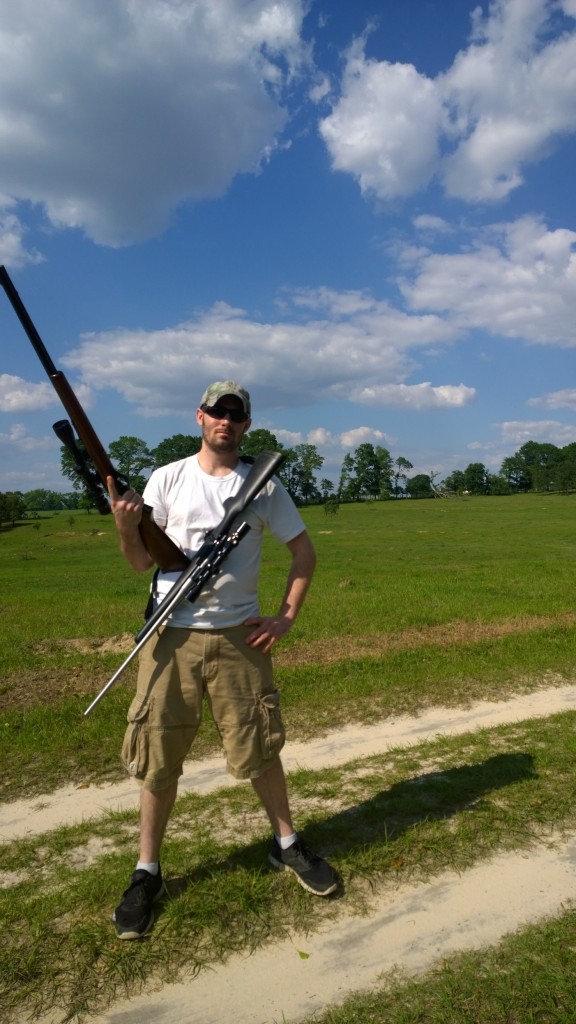
Here he is working out that temper, back in his home state of Alabama while he recovers at his parent’s house
Although David is literally beating the statistics on Traumatic Brain Injury, it is critical to note that, based on research his TBI would have been significantly lessened had he worn his helmet. Even if a helmet cannot eliminate 100% of the risk of a head injury, it can lower the probability of a “severe brain injury” by about 60% (9). It is also probable that he could have avoided the skull fracture all together. Instead of being a Glasgow Coma Scale of 6 on hospital admittance, its possible that he could have been at a 13 to 15, which is a mild to moderate concussion.
At this point, David is expected by his doctors to make a 99% recovery. That being said, he is absolutely not allowed to hit his head again; At least not anytime soon. Research shows that after suffering an initial TBI, the probability of another, even more severe brain injury is dramatically higher (3). Furthermore, TBI is a known independent risk factor for developing Alzheimer’s disease and / or Dementia later in life, as well as for developing pituitary gland conditions such as hypothyroidism (low thyroid), hypogonadism (low testosterone), and / or ACTH disruption (disruption of stress hormones) (4, 16).
An important thing to say here is that although we have highlighted a few of the key, and most well-respected research investigations in the medical literature, this review and bibliography could in fact be well over 1,000 pages long. The amount of published research on TBI, SCI, and risk taking behavior is vast and extensive. For the sake of readability we sought to keep the bibliography under 20 research citations. If one were to review in a full, comprehensive manner the entire database on helmet use, the overwhelming take home message would sound like this:
- Helmets can reduce your risk of [severe] Traumatic Brain Injury by 60-80% across all high velocity activities, including snowboarding and skiing.
- There is little to no statistically significant evidence that wearing a helmet will increase your risk of a cervical Spinal Cord Injury.
- There is little to no statistically significant evidence that wearing a helmet will make you snowboard or ski in a more dangerous, or [riskier] manner.
When examining research, you are diving into the complex and difficult to understand world of statistics. There is no such thing as cause and effect, only correlations and degrees of significance. That being said, when looking at populations there is no better tool to help you make your own personal decisions. Each of you needs to make up your own mind on whether or not to wear a helmet while snowboarding inbounds or out of bounds. One last thing we will say on this note, is that if David had been deep in the backcountry, he most certainly would have lost his life. Because he was airlifted to the ER within one hour of fracturing his skull, he was able to receive the critical medical care that he required. After the unfathomable losses from head injuries of such professional snowboarders and skiers as Aaron Robinson and Sarah Burke, as well as the Olympic career-ending TBI that Kevin Pearce experienced, not to mention many others throughout the years, what decision will you make?
We appreciate any feedback, comments, and / or discussion! After reading this review, has your opinion of wearing a helmet changed at all? In a future blog post we will be discussing backcountry accident response times, and we want to know what you think of helmets as part of a core safety kit? Is your helmet as important as your beacon, shovel, probe, and airbag pack? We want to know what you think!
Stay safe out there!
The Karakoram Team.
Note:
***A meta-analysis is a type of research study that examines multiple other studies performed on the same subject matter, and runs extensive, comparative statistical testing on the results of other research articles. This type of investigation gives tremendous potency over a conventional research article as it dramatically increases the size of data sets, and thus the statistical power of the study.
BIBLIOGRAPHY:
1: Ten Leading Causes of Death: CDC
www.cdc.gov/injury/images/lc-charts/leading_causes_of_death_by_age_group_2013-a.gif
2: Traumatic Brain Injury in the United States: Fact Sheet
hwww.cdc.gov/traumaticbraininjury/get_the_facts.html
(3) Corrigan, Selassie, & Orman (2010). The epidemiology of traumatic brain injury. Journal of Head Trauma Rehabilitation. Volume 25, Issue 2. pp. 72-80. doi: 10.1097/HTR.0b013e3181ccc8b4
(4) Fleminger, Oliver, Lovestone, Rabe-Hesketh & Giora (2003). Head injury as a risk factor for Alzheimer’s disease: The evidence 10 years on; a partial replication. Journal of Neurology, Neurosurgery, and Psychiatry, Volume 74, pp. 857-862. doi:10.1136/jnnp.74.7.857
(5) Ganti, Bodhit, Daneshvar, Patel, Pulvino, Hatchitt, et al. (2013). Impact of helmet use in traumatic brain injuries associated with recreational vehicles. Advances in Preventative Medicine, Volume 2013. Article ID: 450195.
(6) Hagel, Pless, Goulet, Platt, & Robitaille (2004). Effectiveness of helmets in skiers and snowboarders: Case-control and case crossover study. Brittish Medical Journal, Feb. 5th, issue 330, pp. 281.
(7) Hagel, Pless, Platt, & Robitaille (2005). The effect of helmet use on injury severity and crash circumstances in skiers and snowboarders. Accident Analysis and Prevention. Volume 37, Issue 1. pp. 103-108.
(8) Liu, Ivers, Norton, Boufous, Blows, & Lo (2007). Helmets for preventing injury in motorcycle riders. Cochrane Library. Published online Jan. 2008. Doi: 10.1002/14651858.CD004333.pub3
(9) Levy, Allison, Lee & Knight (2002). An analysis of head injuries among skiers and snowboarders. Journal of Trauma-Injury Infection & Critical Care, Volume 53, Issue 4 pp. 695-704.
(10) McBeth, Ball, Mulloy, & Kirkpatrick (2008). Alpine ski and snowboarding traumatic injuries: incidence, injury patterns, and risk factors for 10 years. The American Journal of Surgery, Volume 197, Issue 5, pp. 560-564. Doi: 10.1016/j.amjsurg.2008.12.016
(11) Myles, Hohtadi, Schnittker (1992). Injuries to the nervous system and spine in downhill skiing. Canadian Journal of Surgery, Volume 35, Issue 6. pp 643-648.
(12) Russell, Christie, & Hagel (2010). The effect of helmets on the risk of head and neck injuries among skiers and snowboarders: A meta-analysis. CMAJ, March 9, 2010, Volume 182, No. 4. Doi: 10.1503/cmaj.091080.
(13) Scott, Buller, Anderson, Wlkosz, Voeks, Dignan, & Cutter (2007). Testing the risk compensation hypothesis for safety helmets in alpine skiing and snowboarding. Injury Prevention, Volume 13. pp. 173-177. Doi: 10.1136/ip.2006.014142
(14) Sefrin, Brant, Kredel (2004). Preclinical care of children with traumatic brain injury (TBI). German Medical Science, Volume 2.
(15) Sulheim, Holme, Ekeland, & Bahr (2006). Helmet use and risk of head injuries in alpine skiers and snowboarders. The Journal of the American Medical Association, Volume 295, No. 8.
(17) Tanriverdi, Senyurek, Unluhizarci, Selcuklu, Casaneuva & Kelestimur (2006). High risk of hypopituitarism after traumatic brain injury: A prospective investigation of anterior pituitary function in the acute phase and 12 months after trauma. The Journal of Clinical Endocrinology and Metabolism, Volume
(18) Thompson, Rivara, Thompson, (2000). Helmets for preventing head and facial injuries in bicyclists. Cochrane Database Systematic Reviews, 2000 (2).
(19) Witte & Wilson (2005). Accuracy of WAAS-endabled GPS for the determination of position and speed over ground. Journal of Biomechanics, Volume 38, Issue 8, pp. 1717-1722.

